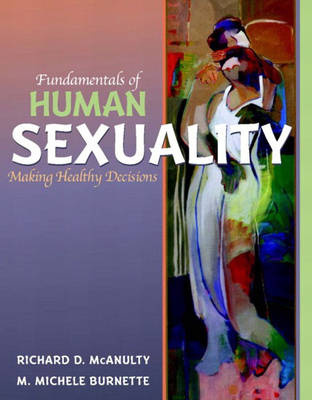
Fundamentals of Human Sexuality
Pearson (Verlag)
978-0-205-35945-5 (ISBN)
- Titel ist leider vergriffen;
keine Neuauflage - Artikel merken
This fundamentals paperback text presents the unifying theme of physical and psychological sexual health while encouraging students to think critically and make healthy decisions about their own sexual attitudes.
By combining the introductory and research methods chapters and the two chapters on sexually transmitted diseases, this briefer version contains two fewer chapters than the comprehensive McAnulty/Burnette text. In addition, a 15-question review test has been added to the end of each chapter.
The primary goal of this text is to promote sexual health and help students understand and make healthy decisions within a framework that integrates physiological, psychological, and social aspects of sexuality. McAnulty and Burnette take a scholarly, research-oriented approach, but present material within a “friendly advisor” framework and writing style, highlighting health issues and diversity. Throughout the text, students are repeatedly challenged to critically analyze and apply information to their own lives in an effort to make the readings relevant and, therefore, easier to learn and retain.
Richard McAnulty and Michelle Burnette The authors are both Clinical Psychologists who received specific training in sexual dysfunctions and disorders while studying at the University of Georgia. Their different areas of professional emphasis and employment settings provide the authors with a broad perspective on human sexuality; this perspective encompasses sexuality and health, including the host of physical, psychological, and interpersonal nuances and factors in sexual adjustment. Dr. Richard D. McAnulty is a professor in the Department of Psychology at the University of North Carolina at Charlotte. He currently teaches human sexuality and advanced topics courses in sexuality. He has written about and conducted research on such topics as measurement of sexual arousal, patterns of sexual arousal in accused child molesters, child sexual abuse, expert testimony in child sexual abuse cases, sexual coercion and dating relationships, religiousness and pedophilia, and topless dancers. He co-edited The Psychology of Sexual Orientation, Behavior, and Identity and has served on the editorial boards of several journals, including The Journal of Sex Research. He currently specializes in the assessment and treatment of sexual disorders. Dr. M. Michele Burnette formerly was a tenured Associate Professor in the Department of Psychology at Western Michigan University. She taught human sexuality at the undergraduate level for several years as well as graduate-level courses on sexual dysfunction and therapy. Her research activities focused on the behavioral management of genital herpes recurrences, AIDS attitudes and behaviors, acquaintance rape, and the impact of exercise on sexual function. In her years of clinical experience she conducted relationship therapy and counseled clients for sexual dysfunctions and disorders, posttraumatic stress disorder (including post-rape trauma), childhood sexual abuse, infertility, and perinatal complications and bereavement. Dr. Burnette also completed a Research Fellowship in the Department of Epidemiology at the University of Pittsburgh's Graduate School of Public Health. While conducting research on the impact of health behaviors on cardiovascular health in women, Dr. Burnette obtained a Master of Public Health degree. Currently, she is a part-time writer and teacher at area colleges, including the University of Pittsburgh.
Each chapter opens with a chapter outline, chapter opening story or quotes, and concludes with a section titled “Healthy Decision Making,” and a chapter summary.
1. Sexuality Today.
Contemporary Trends.
Major Sociocultural Influences.
Historical Perspectives on Sexuality.
Current Theoretical Perspectives on Sexuality.
Research Methods in Sexuality.
2. Sexual Anatomy.
Female Sexual and Reproductive Anatomy.
Preventative Care of the Female Sexual and Reproductive Anatomy.
Male Sexual and Reproductive Anatomy.
Preventative Care of the Male Sexual and Reproductive Anatomy.
3. Physiology of Sexual Arousal and Response.
Models of Human Sexual Response.
The Sexual Response Cycle.
Neural and Hormonal Control of Sexual Response.
Other Factors Affecting Sexual Response.
4. Conception, Pregnancy, and Childbirth.
Conception and Fetal Development.
The Experience of Pregnancy.
Prenatal Care.
Prenatal Medical Complications.
Infertility and Technological Advances in Conception.
Advances in Testing and Treating Fetal Problems.
Labor and Delivery.
The Postpartum Period.
5. Contraception and Abortion.
Contraception.
Contraceptive Methods.
Abortion.
6. Sexual Development from Birth through Adolescence.
Theories of Sexual Development.
Childhood Sexuality: Birth to Eight Years.
Pre-Adolescent Sexuality: Eight to Twelve Years.
Sexuality in Adolescence: Twelve to Eighteen Years.
Issues in Adolescent Sexuality.
7. Sexual Development in Adulthood.
Psychosocial Challenges of Adulthood.
Singlehood.
Cohabitation: An Alternative to Marriage?
Marriage.
Divorce.
Sexuality and Aging.
8. Gender Roles and Sexuality.
Prenatal Sex Differentiation
Sex, Gender, and Challenges to Stereotypes.
Biological and Social Theories of Gender.
A Closer Look at Environmental Influences.
Gender Roles and Interpersonal Relationships Between Genders
Similarities and Differences in Male and Female Sexuality.
9. Sexual Orientation.
Sexual Identity Formation.
Prevalence of Heterosexuality, Homosexuality, and Bisexuality.
Determining Sexual Orientation: Nature vs. Nurture.
Sexual Communities.
Relationships.
The Lesbian/Gay Movement.
Heterosexism and Homophobia.
10. Love and Sensual Communication.
Love.
Love Relationships.
Maintaining a Love Relationship.
Conflict in Love Relationships.
Resolving Relationship Conflict.
Relationship Problems.
Sex and Sensual Communication.
11. Sexual Coercion.
Sexual Assault.
Sexual Abuse and Incest.
Sexual Harassment.
12. The Sexual Dysfunctions.
Types of Dysfunctions.
General Causes of Sexual Dysfunctions.
Treatment of Sexual Dysfunctions.
13. Commercial Sex.
Pornography.
Adult Entertainment.
Prostitution.
14. Atypical Sexual Behavior.
What Is Atypical Sexual Behavior?
General Features of Atypical Sexual Behavior.
Non-Coercive Sexual Behavior.
Coercive Sexual Behavior.
Explanations of Atypical Sexual Behavior.
Treatment of Problematic Sexual Behavior.
15. Sexually Transmissible Infections: Symptoms and Transmission.
The STI Epidemic.
Common Causes of Vaginal Infections.
Parasitic Infections.
Bacterial Infections.
Non-HIV Viral Infections.
The HIV Epidemic.
Diagnosis and Treatment of Non-HIV Sexually Transmissible Infections.
Diagnosis and Treatment of HIV.
Living with Incurable Sexually Transmissible Infections.
Reducing the Risks for Sexually Transmitted Infections.
STI Risk Reduction: Does It Work?
16. Health and Human Sexuality.
Life-Threatening Illnesses.
Chronic Illnesses.
Physical Disabilities and Sexuality.
Protecting Your Sexual Health.
| Erscheint lt. Verlag | 3.10.2002 |
|---|---|
| Sprache | englisch |
| Maße | 216 x 276 mm |
| Gewicht | 1127 g |
| Themenwelt | Sachbuch/Ratgeber ► Gesundheit / Leben / Psychologie ► Partnerschaft / Sexualität |
| Geisteswissenschaften ► Psychologie ► Sexualität / Partnerschaft | |
| Sozialwissenschaften ► Soziologie ► Gender Studies | |
| ISBN-10 | 0-205-35945-0 / 0205359450 |
| ISBN-13 | 978-0-205-35945-5 / 9780205359455 |
| Zustand | Neuware |
| Haben Sie eine Frage zum Produkt? |
aus dem Bereich


